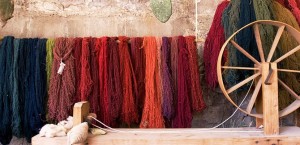
Humankind has always been fascinated by colors for social and aesthetic reasons. Dyes and pigments which are the two color sources total to about 9000 in number today. A number of causes such as requirement of wide array of tints and hues, chemical composition of the substances to be colored and the direct relation of color to the molecular structure of the dye has led to the existence of this vast number.
Between dyes and pigments it is the pigments which are supposed to lend more vibrant colors. If one has to trace the history of impartation of color; then it all began from the discovery of natural dyes. One of the earliest natural dyes is said to be blue dye indigo which up to recent times had been a preferred choice for denims till it was replaced by synthetic indigo. The natural dye that is still in use to a small extent today is logwood. This is combined with chromium to give gray, black and charcoal hues for use in silk and leather industry. Direct application of natural dyes was not possible for fabrics like cotton and this necessitated pre-treating the fabric with inorganic salts. These were known as mordants. Mordants ensured that the dye color was retained on to the fabric. However, economic limitations of natural dyes and discovery of synthetic dyes led to their slow death. The first commercially viable synthetic dye was mauve which was discovered in the 19th century. The discovery of this dye gave an impetus to the introduction of several other synthetic dyes. Many years of dedicated research, trial and error has brought the dye industry to the stage it is today.
It is the varied features of the dyeing process that ensure the dye fulfills its function of imparting color to the application effectively. Firstly it has to be seen that the dye is evenly and directly associated with the substrate to provide even coloring which offers a certain degree of resistance to heat, moisture and light. The dyeing process should be such that the dye molecules are placed within the fiber’s microstructure. Chemical reactions taking place between substituents on fiber and dye molecules lead to creation of covalent bonds which enable the dye molecules to anchor effectively on the fiber. Such dyes are called reactive dyes. There are other dyes which can impart color by just dipping the fabric into the aqueous solution of the dye. These dyes are direct dyes. Every dye has a unique name based on their value, hue and chroma. For example, Direct Black 22 is one such unique name of a dye belonging to the category of direct dyes. The color impartation process works differently for different dyes such as basic dyes, vat dyes, acid dyes and so on as each dye has its own typical features. There are several other factors like fibre porosity that also determine the suitability of a specific dye. Understanding the process will help you to know which of the dyes best suit your application.